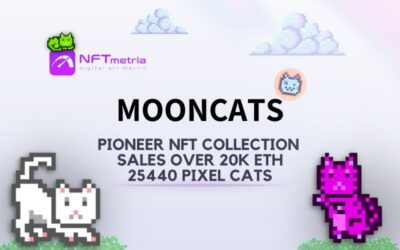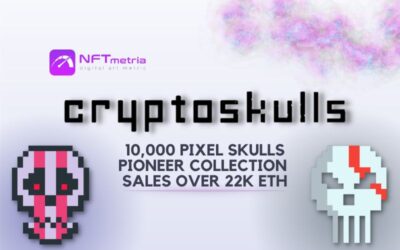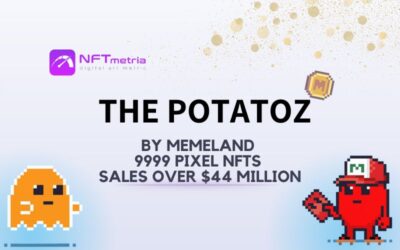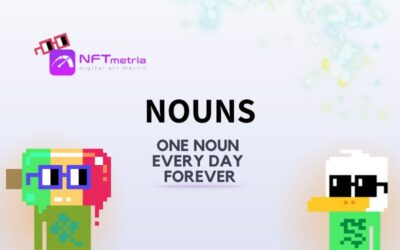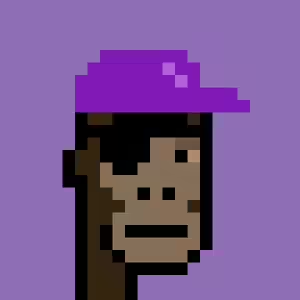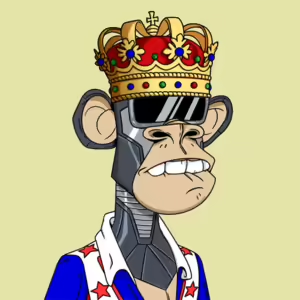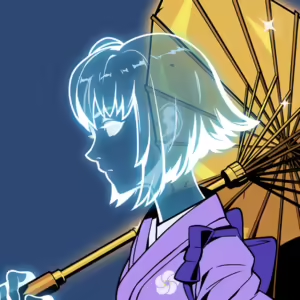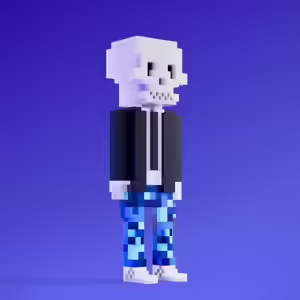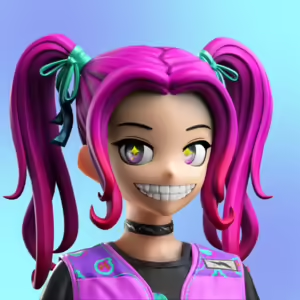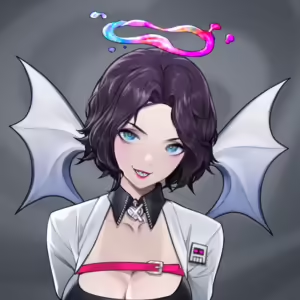MoonCats is by no means an ordinary collection. It is only 6 weeks younger than the NFT pioneer CryptoPunks. This alone makes Mooncat a gold mine for NFT archaeologists and crypto enthusiasts.
But historical value is not the only feature of this collection. Born on August 10, 2017, it has experienced undeserved oblivion, a miraculous revival on March 12, 2021, and incredible success. The resurrection from the dead transformed the old MoonCats into new, investment-attractive NFT assets, making the project a special “vintage nouveau” status.
In the last week of August 2021, the collection saw sensational growth. As a result of 1,050 MoonCat NFTs sold during the month, the collection’s trading volume increased by 1,128% to over $4.4 million, and the average price reached $4,190 (1.3 ETH).
Our experts tried to uncover the secret of this unprecedented success. What lifted the project to the pinnacle of fame? Crazy luck or daring innovation? Stay tuned, there’s more to come. Maybe you’ll discover a new gold mine.
MoonCats Official Links
- Official website of MoonCatRescue https://mooncatrescue.com
- Official website of MoonCatCommunity https://mooncat.community
- Twitter @mooncatrescue – over 3.5k followers;
- Discord @mooncats – over 16.5k members.
What is MoonCats?
MoonCats are 25,440 pixel NFTs depicting cats procedurally generated from ETH blockchain data. The attributes (color, fur pattern, pose, face expression) were determined at the initiation of the minting transaction.
According to the legend of the project, the minting process involved an operation to save cats, inhabitants of the moon, from a solar eclipse. The owners of the rescued digital pets were given the opportunity to name them and pick up accessories for them.
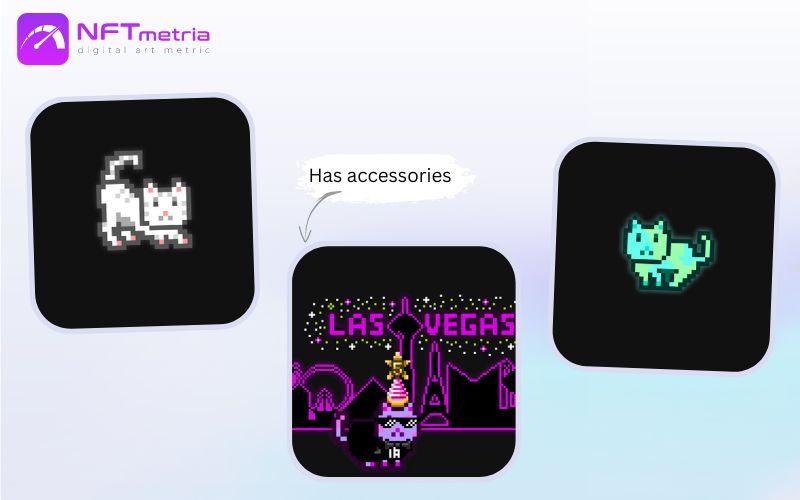
Initially, more than 4 billion variants of tokens were offered for minting, but only 25,600 of them were added to the project’s smart contract, which turned out to be the capacity of a “spacecraft with the latest toilet technology”.
The collection eventually included 25,344 rainbow Rescue characters and 96 black and white Genesis MoonCats (who refused to leave the moon base). In the March 2021 vote, 160 of the planned 256 Genesis characters were permanently blocked. Thereafter, the minting was discontinued.
The peculiarity of Genesis collection was that it was impossible to save them (that is, to mint them, paying only for ETH mining). But you could adopt them (giving 0.3 ETH for one, with each subsequent round increasing the price by 0.3 ETH). In addition, Genesis NFTs had unchanged traits: black specimens were depicted only in a jumping or standing pose, and white specimens were depicted in a chasing or sleeping pose.
Mooncats in numbers
- The minting of a collection of 25,440 NFTs took place on August 10, 2017.
- Only 19,551 out of 25,440 tokens are in circulation on OpenSea.
- The total volume of secondary sales exceeded 20k ETH (more than $36 million at the current exchange rate).
- Floor price is 0.26 ETH (about $470).
- Average sales range from 0.21 ETH to 0.9 ETH.
- The most expensive #527: 0xff13000ca7 was sold on August 28, 2021 for 160 ETH (about $522k at the time of sale). It is owned by Logan Paul.
- Total 5,828 unique holders (30%).
- Only about 1% of the collection (258 pieces out of 19,551) are for sale, among them the offers range from 0.26 ETH to 1,337 ETH. This shows that almost all holders see the project as a great investment prospect and are not in a hurry to part with their assets at a lower price.
Data (including exchange rates) are given at the time of publication (March 30, 2023)
MoonCats types and attributes
The collection includes 751 attributes divided into 18 categories. Among them are the following:
- Accessory (12),
- Classification (2),
- Coat (104),
- Expression (4),
- Has Clones? (2),
- Has Mirrors? (2),
- MoonCat ID (500),
- Only Child? (2),
- Pose (4),
- Rescue Year (5),
- SpokesCat For (84),
- Looprint (2).
Who Created MoonCats?
The developers of the project prefer to keep their privacy. All we know is that their names are David and Jason, both employees of Ponderware @ponderware.
David once admitted to podcaster and influencer Kevin Rose that the limitless possibilities of smart contracts is what inspired him and Jason to develop the NFT project:
Moon, cats, the internet – it just all sort of came together. The co-founder of the project says
In other words, the Ponderware duo created the blockchain project as an attempt to explore the potential of decentralized applications.
Why is MoonCats popular?
Since the project’s revival, the Ponderware team has been a frequent guest on podcasts, and it’s also featured in numerous news releases and publications. In October 2021, Sotheby’s created a significant display for MoonCats and attracted a lot of collectors to it.
Today, the collection continues to stir the imagination of NFT collectors. And here are the main reasons for the enduring popularity of the collection:
- The community’s enduring interest in the collection is fueled by a compelling story, the “Insanely cute operation” to save MoonCats from a catastrophic solar eclipse (who wouldn’t want to feel like a benefactor of the cutest creatures in the universe?);
- The project’s arsenal of tools allows every collector to leave their mark on the blockchain, from the ability to name their NFT (using Irrevocable Naming), to unlocking accessories to customize their NFT (using Accessory Designer) and selling or buying accessories from MoonCat Boutique for commercial use of NFTs and development of derivative project.
- The ability for community members to create rare NFT characters, such as Garfield, that gain special value and popularity (this makes MoonCats very different from many other NFT projects, in which rarity collectibles are created by developers).
- Collectors may not only choose accessories for their pet, but also decide whether to hide them or show them off. Acquired accessories remain with the corresponding NFT cat and cannot be sold or transferred separately from it. The name assigned to a pet once also stays with it forever.
- The advanced Acclimator feature allows you to change the outdated original NFT ERC-20 standard to the current ERC-721 version (compatible with modern wallets), which facilitates transactions on OpenSea, Rarible and other marketplaces, and also allows you to use all the benefits of the project’s ecosystem.
- In addition to external marketplaces, the community has its own convenient marketplace, MoonCat Adoption Center.
- The Cudl.finance team has released a blockchain game that lets you use NFTs from the MoonCatRescue collection as a kind of tamagotchi.
- After the project was discovered by NFT archeologists (Adam McNFT, 0xAllen, JUSTIN, ETHoard) and revived, Logan Paul, a famous podcaster, YouTuber, wrestler and actor, joined the community. He proudly announced on his Twitter that he had purchased Grumpy Genesis, a pure-white NFT Cat, for 160 ETH ($522,000).
Finally got a #Mooncat!
Dropped 160 Eth ($522k) on this Pure White Grumpy Genesis Mooncat. One of the first NFT projects, right after CryptoPunks.
History = 📈 pic.twitter.com/7vz8XVxNHD
— Logan Paul (@LoganPaul) August 28, 2021
MoonCats Idea
In an interview with Bankless HQ, the creators of the project expressed the idea in the following way:
Our primary driver has, and continues to be, innovation. We want to continue to drive new ideas into the crypto and NFT space; staying true to this ideal has produced the MoonCatBoutique, where you can customize your kitties, and lootprints (for MoonCats), spaceship blueprints you can use in future ecosystem developments. David and Jason said
In addition to promoting cutting-edge technology, the project’s humanitarian mission is to draw attention to homeless creatures in need of rescue.
MoonCats Roadmap
The MoonCats community site details the project’s plans for both the near and the distant future.
The first section entitled Short-range scanners includes the following projects:
- Astral Projections: Further adaptation of NFT cats to Isotile and Worldwide Web3. Developing land estates in Isotile and looking for new ways to integrate avatars and pets of the metaverse into Worldwide Web3.
- The Shipyard: The evolution of the lootprints project (for MoonCats) will allow each collector to create a spaceship based on their blueprints and pilot it on a journey through the multiverse in the company of MoonCat.
- GravBall: The launch of an idle-style game with digital cats and their owners acting as trainers, observing the game and influencing its outcome.
- Purrrfect Blend: Empowering the community with a set of tools created to help them better navigate the ecosystem.
- Autographs: Simplifying the naming process to allow more owners to use new names.
The second section of the roadmap, Long-range scanners, presents projects in the idea / design stage:
- Linguistics: Creating new chapters in the MoonCats’ rescue story by community members.
- Treasure Planet: Developing new collectibles that could be collected by the MoonCats themselves, not just by their owners.
- Deep Space: A penetration into the far reaches of the universe that will allow collectors to discover where their pets come from (the project involves staking, contests, and other interesting features).
MoonCats Ecosystem
The active support of the project’s community leads to an ongoing expansion of the MoonCat Ecosystem. It includes several elements.
JumpPort smart contract
JumpPort is a key element of the project’s infrastructure that allows MoonCat to expand its interaction, including with Layer 2 (L2) ETH blockchain solutions. The JumpPort smart contract acts as a lockbox that can be extended for interactions such as staking, cross-chain bridging, and other applications.
Lootprints (for MoonCats)
Lootprints (for MoonCats) is an NFT collection (ERC-721) created in September 2021 by the MoonCatRescue community, representing blueprints of spaceships. The collection opens access to the GravBall game which is under development, and each player must have at least one MoonCat and at least one Lootprint.
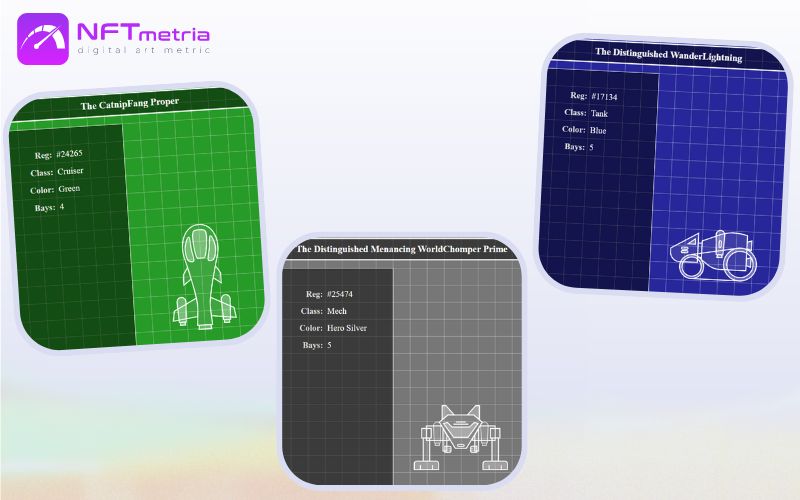
During the 6-week minting process, 11,718 of the 25,600 Lootprints offered were issued. The registration number and color of these tokens are directly related to the corresponding MoonCats. The name, type, and number of Bays (settings) are randomly generated during minting. Total volume of Lootprints (for MoonCats) amounts to 269 ETH.
Wrapped MoonCatsRescue (Unofficial)
Wrapped MoonCatsRescue (Unofficial) are 1,600 collectible NFT cats created by independent developer Polyself after MoonCats revival in March 2021.
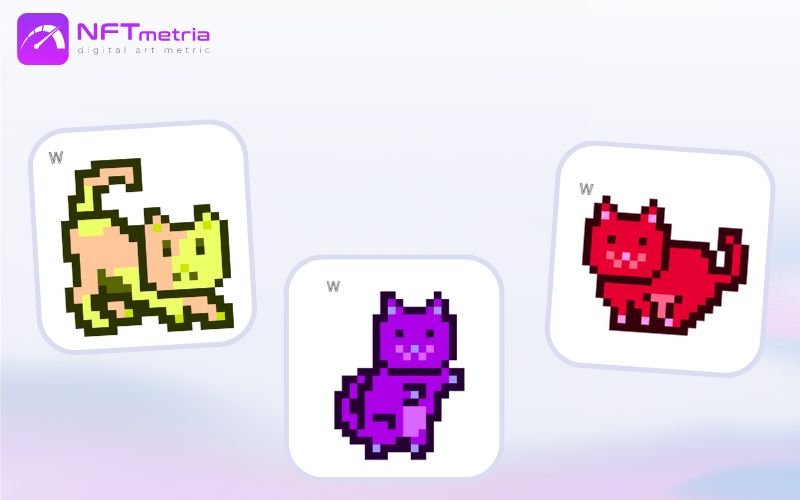
These NFTs use a third-party wrapper service, so they are not provided with metadata or integration with Ponderware developments. Total volume is 7,529 ETH, floor price is 0.9 ETH.
MoonCat Lottery Pet
MoonCat Lottery Pet is a tamagotchi game with MoonCats characters, launched in June 2021 by the Cudl Finance team. The point of the game is to earn a reward in the form of $CUDL (ERC-20 token) when you feed MoonCat. Each $CUDL is a ticket that participates in a weekly lottery in which a smart contract randomly selects 4 winners.
The prizes are as follows:
- 1st place: new pet,
- 2nd place: 38% of the total $CUDL tokens earned during the week,
- 3rd and 4th places: 19% of the total earnings.
How much do MoonCats cost?
The collection was released on August 10, 2017. At that time, the NFT market was not yet quite developed, but even then the project had external interest. After that, in 2021 MoonCats gained a second wave of popularity. In the last week of August 2021, the collection saw sensational growth. With 1,050 NFTs sold during the month, the collection’s trading volume increased by 1,128% to over $4.4 million, and the average price reached $4,190 (1.3 ETH).
To visualize the price dynamics, we made a slice of the average price for 1 NFT:
- In April 2021: 0.5 ETH;
- In October 2021: 1.3 ETH;
- In March 2022: 0.9 ETH;
- In November 2022: 0.4 ETH;
- In February 2023: 0.5 ETH.
As of March 30, 2023, the floor price is 0.26 ETH. On average, the latest sales range from 0.21 to 0.9 ETH. And the total volume of secondary sales amounted to more than 20k ETH (more than 36 million dollars).
The Most Expensive Sales of MoonCats
The most expensive sales are led by the following NFTs from the MoonCats collection:
- #527: 0xff13000ca7 was sold on August 28, 2021 for 160 ETH (about $522k at the time of sale). It is owned by Logan Paul.
- #2876: 0xff50000ca7 was sold on August 25, 2021 for 88.8 ETH (about $287k at the time of sale);
- #1117: 0xff2f000ca7 (accessorized) was sold on August 25, 2021 for 75 ETH (about $242k at the time of sale);
- #90: 0xff06000ca7 (accessorized) was sold on January 22, 2022 for 74.69 ETH (about $180k at the time of sale).
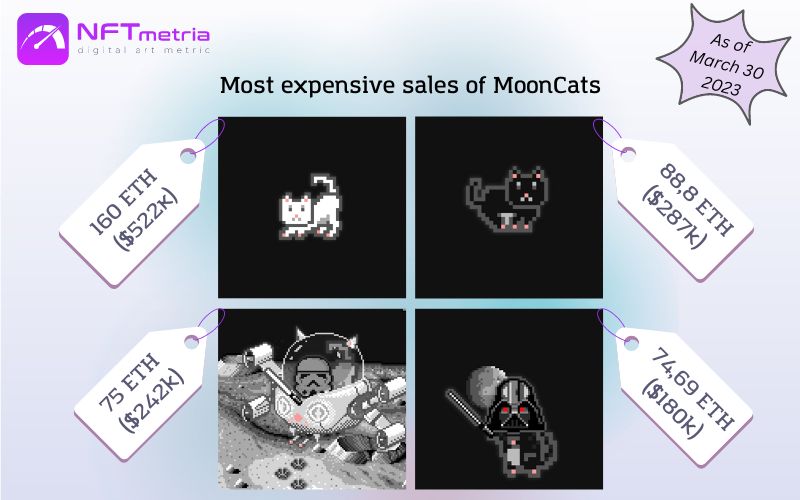
Where to buy MoonCats?
Currently, MoonCats can only be purchased on the secondary market, on marketplaces such as OpenSea, X2Y2 and LooksRare.
How to buy MoonCats?
- Remember that initially you need to connect your crypto wallet with self-storage to the marketplace of your choice.
- Next, find the official collection using the search bar on the marketplace.
- Analyze and choose the NFT you want to buy; click on it and then on the “Buy” button.
- Or you can bet on the token you like. Make sure you leave enough ETH for gas or transaction fees. If the seller approves your bid, the deal goes through.
Should you invest in MoonCats?
Experts compare investing in vintage digital art objects to investing in stocks. The MoonCats historic collection is indeed a high value, as the following facts convince us:
- The project behind the collection has a strong technological arsenal, is the developer of many useful tools, and offers a clear roadmap for users to consider. All this makes the project’s long-term viability evident.
- The price history of the collection shows its high potential. In March 2021, for example, the average price of these NFTs was 0.8 ETH, which allowed those who paid around 0.02 ETH for the minting to sell them with profit. Today, the collection’s minimum price is a stable 0.25 ETH.
- The wrapping fee ($200) introduced in 2022 seems nominal, given that some NFTs were selling for almost $40k at the time.
- Each collector has a commercial and personal license to their NFT image.
When deciding to invest in this collection, keep in mind that the higher priced ones are:
- Genesis MoonCats (as opposed to Rescue MoonCats);
- Early Rescue MoonCats (2017-2020), the most valuable of which have numbers #0-#3364. These cats can bring in 100 times the profit. The most expensive of these is #0. As for the cheaper tokens minted in March 2021 (so-called “floor cats”), their price rarely falls below 1 ETH;
- Cats characters connected with pop culture: Garfield (main character from famous comics), Cheshire Cat (reminding of disappearing cat with a smile from Lewis Carroll’s story “Alice in Wonderland”), Alien Cat (evoking associations with “Alien” from CryptoPunks).
In any case, do your own in-depth analysis and research when investing in NFTs, and then make your own decision.
Opinion of NFTmetria
MoonCats is an innovative project in many ways:
- It was one of the first on-chain generative NFT collections,
- It was the first to put cats in the Ethereum ecosystem,
- It was the first to provide collectors with support for naming and fair distribution functions.
Ponderware developers’ research of the multidimensional blockchain universe opened the way for a technological breakthrough. The smart tools they created have turned many plans and dreams from concepts into reality!
How the life of MoonCats that have settled on the Ethereum network will turn out is hard to predict. One thing is clear: more and more people around the world consider this project historically and culturally significant. We want to believe that the playful MoonCats company will not once again intrigue collectors with exciting activities.

